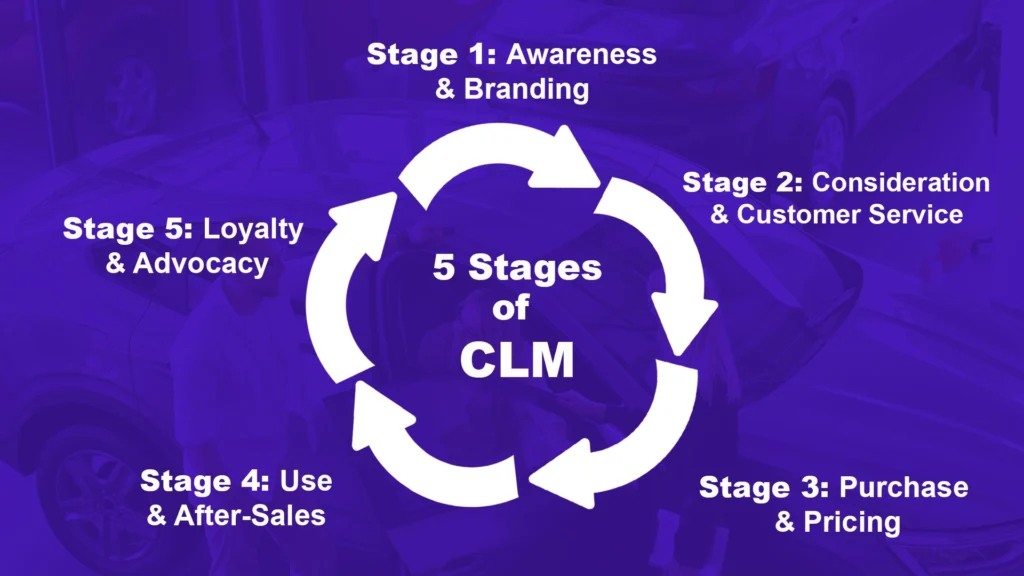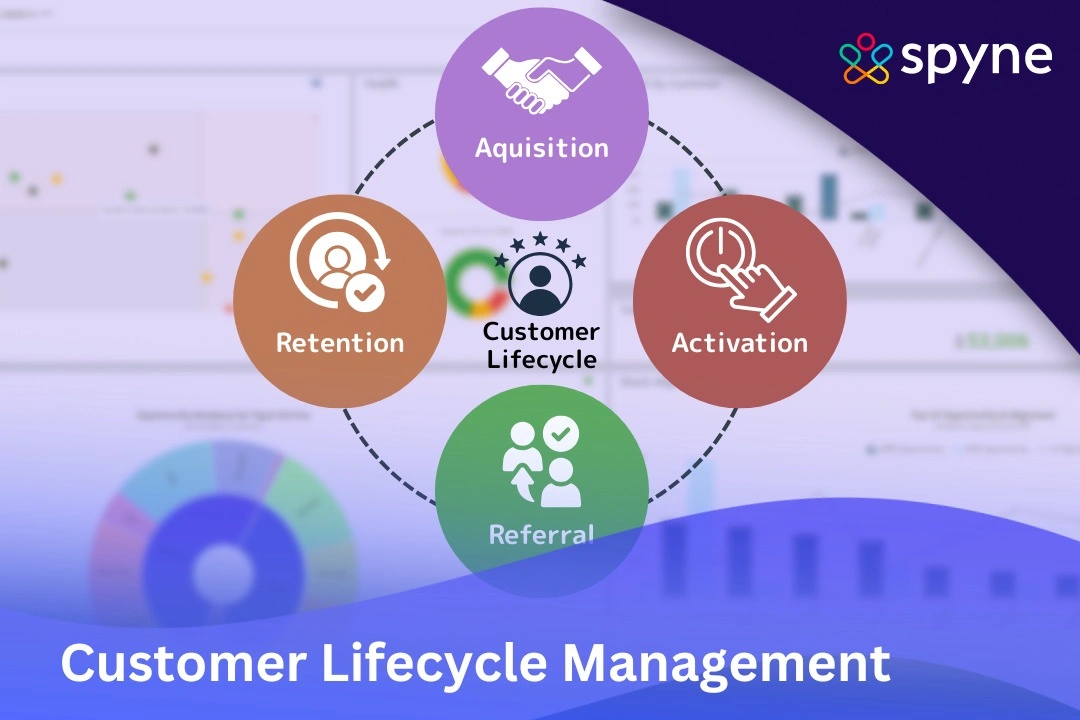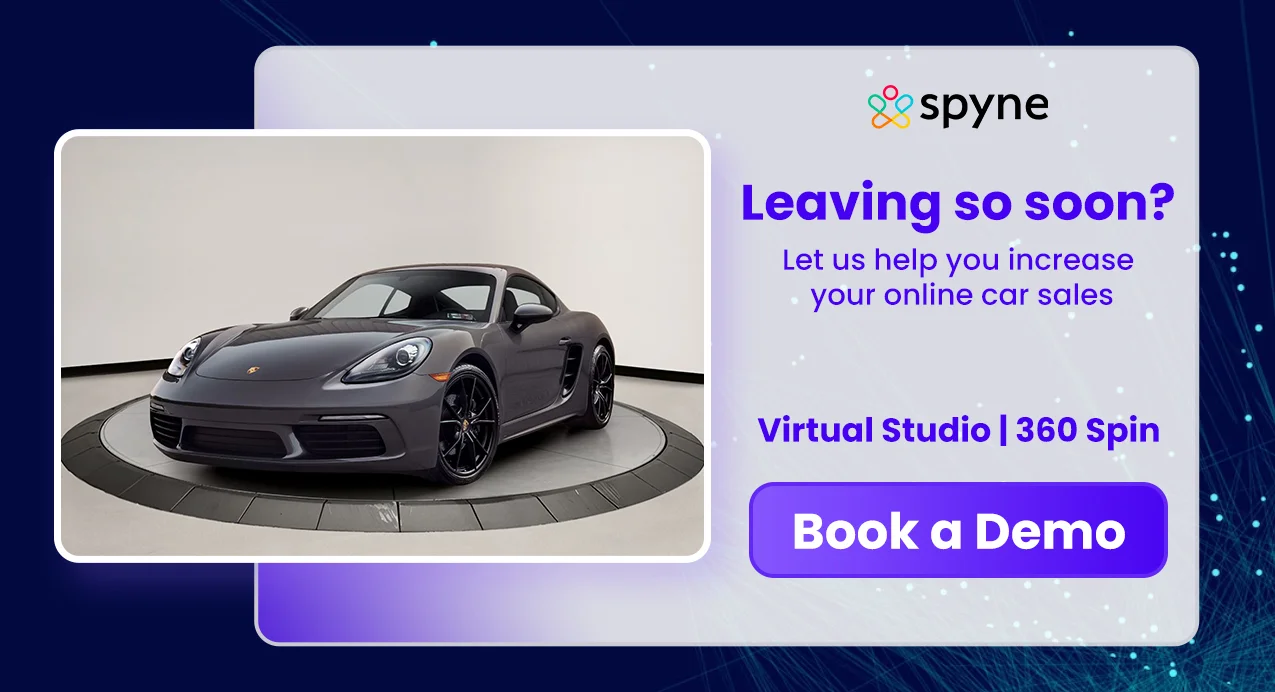Customer lifecycle management is the process of guiding customers through every stage of their journey. It begins with first discovering your brand, and becoming loyal customers who speak for your brand to others. With the right tools and strategies that companies like Spyne offer, it’s become much easier for businesses to create personalized experiences, improve customer satisfaction, and drive long-term value. So, this blog explores CLM’s stages, strategies, software types, and benefits, and tells you about AI-powered tools that help you grow every step of the way.
What is the Customer Lifecycle?
The customer lifecycle describes the different stages a customer goes through when interacting with a business. This ongoing process starts with learning about a product and ends with becoming a loyal buyer. It helps companies understand how to engage customers effectively at each step. Additionally, using customer life cycle management allows teams to see the full journey and personalize their efforts to ensure that customers return.
These are the typical stages of a client lifecycle:
- Awareness – when potential customers first hear about your product or service.
- Engagement – when they show interest, start researching, and decide to buy.
- Conversion – when they actually purchase or sign up for a demo.
- Retention – keeping customers engaged after their first purchase.
- Advocacy – when recently converted and loyal customers recommend your brand to others.
So, when your client lifecycle management approach is strong, your business can track each stage, improve customer experience, and grow long-term value.
What is Customer Lifecycle Management?
Customer lifecycle management is a strategy that helps businesses track and understand every step a customer takes, from the initial contact to the final sale and after-sales loyalty. It focuses on managing relationships throughout the entire customer relationship life cycle to improve satisfaction and boost repeat sales.
This process is mainly automated and uses various sets of data and metrics collected at each stage of the customer’s process. It makes it easier for businesses to give their buyers more personalized experiences. Many companies use a CLM platform or customer lifecycle management software to gather important information and guide marketing, sales, and support teams.
With client lifecycle management tools and a clear customer life cycle model, companies can manage the different stages more efficiently and even get back lost customers. Therefore, integrating the customer life cycle in CRM systems helps track the CRM life cycle and build stronger, lasting connections.
Why Customer Lifecycle Management is Important for Businesses
Good customer experiences aren’t luck or coincidences, they’re built through effort. Customer lifecycle management gives businesses the tools to look closely at every step of the customer journey. Doing this helps companies spot issues as soon as they arise, offer better support, and create a consistent process that improves results over time. Additionally, a well-planned strategy helps teams divide their attention properly between sales and customers after they buy.
A strong customer success lifecycle all depends on how satisfactory your experience is. Using client lifecycle management, you can reduce the rate at which customers abandon your business, increase satisfaction, and improve overall value from each customer. It’s simple; in today’s market, customers are given many choices. If they’re unhappy with the service, they’ll switch. That’s why tracking the customer relationship life cycle and checking in on account health is essential. Using tools like a CLM platform or customer lifecycle management software helps detect early warning signs and keeps your customer cycle strong and active throughout the process.
Understanding the 5 Stages of Customer Lifecycle Management
Customer Lifecycle Management (CLM) follows five key stages: Awareness, Acquisition, Conversion, Retention, and Advocacy, which guide businesses in creating consistent, personalized journeys to boost customer lifetime value.
1. Awareness: Getting Discovered
The first stage of the 5 stages of customer life cycle is when potential buyers discover your business through ads, social media, SEO, or referrals. A good platform ensures your brand is visible and relevant during this early stage.
2. Engagement: Building Interest
The next stage involves nurturing leads by offering helpful content and answering their questions. Client lifecycle management tools can help personalize experiences and highlight why your product or service is the right fit.

3. Conversion: Turning Interest into Profitable Action
At this stage, a lead becomes a paying customer. Here, you should use customer lifecycle management software to make the online payment process simple, resolve last-minute concerns, and personalize communication to improve conversion rates.
4. Retention: Keeping the Relationship Alive
Once a customer has purchased your product, it’s about maintaining trust. Regular follow-ups, exclusive offers, and personalized support can improve satisfaction. This phase is essential in the customer success lifecycle and impacts long-term customer lifetime value.
5. Advocacy: Creating Brand Ambassadors
Happy customers share their experiences. If they’re satisfied with their experience, you can encourage reviews, referrals, and reward loyalty. This final phase helps close the loop and strengthens every stage of your customer life cycle management strategy.
6 Winning Strategies of Customer Lifecycle Management
Managing the customer lifecycle means guiding customers from awareness to advocacy by mapping their journey, setting clear goals, personalizing experiences, and using the right tools to build lasting relationships.
1. Identify the Customers You’re Targeting
Start your customer relationship life cycle by deciding who your ideal customer is. You can do this by identifying demographics, buying behaviour, and pain points to target your outreach more effectively.
2. Map Out the Full Journey
Next, paint a visual picture of the entire customer life cycle model, from awareness to loyalty. Making a journey map helps you uncover potential issues, understand customer needs, and track progress through the 5 stages of customer life cycle.
3. Set Goals That Work Well with Business Outcomes
Identify your customer lifecycle management stages and set clear goals for each. It’s important to know what you want to achieve. Additionally, you can use lifecycle data like CLV and churn rate to guide your strategy.
4. Use Data, AI & Help Centers to Support Customers
Use customer lifecycle management software, AI tools, and self-service content to improve support, speed up resolutions, and create better experiences. Understand that it’s a constant learning process.
5. Create Multi-Channel Customer Contact Points
Ensure that you’re connected with customers everywhere. Build the customer relationship management life cycle by connecting across chat, SMS, social media, and feedback surveys.
6. Personalize Every Step of the Way
The cycle is complete when you use insights from a CRM life cycle to personalize experiences and encourage long-term engagement. This is great for boosting customer lifetime value across the customer lifecycle.
Customer Lifecycle Management: 6 Points for Analyzing the Customer Life Cycle
Customer lifecycle management means tracking how customers go from first discovering your brand to becoming loyal advocates. By mapping their journey, you can improve experiences and boost satisfaction at every step.
1. Go In-Depth to Understand Your Customer Life Cycle Model
Once you’ve defined your ideal customer, you can start creating the customer life cycle in CRM. It starts with awareness and goes all the way to loyalty. Knowing these stages helps you manage your customer success lifecycle effectively.
2. Visualize the Client Lifecycle Journey
Monitor every interaction your customers have across channels like social media and email. This helps you see how clients move through the client lifecycle and spot the right moments to engage.
3. Track Standout Metrics With Your CLM Platform
It’s important to measure CRM metrics like Customer Lifetime Value (CLTV), churn rate, and conversion rates using your customer lifecycle management software. So, why is it important? These numbers show how well your client lifecycle management software performs.
4. Identify Drop-Offs and Customer Pain Points
Find where customers lose interest or face problems in the cycle. Then, analyze feedback to fix issues early and improve your customer life cycle management.
5. Use Reports to Improve Every Stage
Your efforts should reap benefits! Apply your analysis to personalize experiences, simplify steps, and boost satisfaction throughout the CRM life cycle.
6. Incorporate AI to Make Management Easier
Get with the times and include AI-powered tools and a well-programmed CLM platform to automate communications. This way, you’d be keeping content relevant and customers satisfied.
7 Customer Lifecycle Management Best Practices to Boost Growth
Effective customer lifecycle management means putting your customers first by knowing what they need, personalizing their journey, and using feedback and data to continuously improve every step they take with you.
1. Walk Through the Journey from the Customer’s View
The key to customer lifecycle management is seeing it from the customer’s point of view. Understand each phase of the customer success lifecycle, from product awareness to final sale. This helps improve engagement and bring you one step closer to loyalty.
2. Keep Customer Data Under One Dashboard
Your data should always be organized to avoid mistakes. Use tools like client lifecycle management software or a CRM to organize contact data, remove duplicates, and align teams across sales, service, and operations.
3. Personalize Your Reach by Organizing Your Customers
Create different customer profiles based on their recent interactions, behaviour, and preferences. This way, you can deliver targeted promotions, helpful content, and relevant offers that deepen loyalty and trust.
4. Make the Purchase Process Simple and Convenient
Simplify the checkout process so buyers don’t drop off if your purchase process is too complicated. Reduce the number of steps and documents, offer flexible payment and shipping options, and track what slows buyers down.
5. Automate for Efficiency and Consistency
The basic tasks should definitely be automated. Automation in your CRM life cycle helps manage follow-ups, reminders, surveys, and onboarding flows. Additionally, automation scales with you as you grow.
6. Stay Connected Post-Purchase
Don’t let interactions die down after a purchase. Follow up with customers to gather feedback, offer support, and strengthen retention using your customer life cycle in CRM tools.
7. Encourage Customers to Speak for Your Brand
Ask customers for reviews, reward them when they refer you, and proactively listen to loyal customers to boost long-term growth.
Top 7 Benefits of Customer Lifecycle Management for Automotive Dealers
Customer lifecycle management helps auto dealerships build stronger relationships, boost sales, and streamline automotive inventory management by using smart tools to personalize interactions, track leads, and improve the entire buyer journey.
1. Build Stronger Relationships with Real-Time Engagement
Connect with car buyers at every step of the automotive customer lifecycle using real-time tools. When your CLM platform works from a single dashboard, you can personalize each interaction and earn long-term loyalty.
2. Understand Buyer Behaviour to Increase CLV
You can use your customer life cycle management data to organize buyers, predict actions, and create offers. These help you reach a more targeted audience and encourage customer lifetime value.
3. Use Automation in Your Daily Tasks
AI-powered workflows in your client lifecycle management tool help rekindle lost sales opportunities, trigger upsells, and improve results throughout the customer life cycle automotive journey.
4. Personalize Using Valuable Data
Use live and historical data to reach the right audiences with smart, timely offers. Remember that great automotive customer experience management leads to loyalty in the long run.
5. Make Post-Sale Loyalty Easy
You can build trust with reward programs, exciting referral offers, and tier-based perks. All of this can be managed within your vehicle lifecycle management system.
6. Let CRM Do the Groundwork for You
Who says administrative work has to be lengthy and time-consuming? AI-powered automotive CRM systems enhance follow-ups, lead tracking, and marketing. This is key for strong customer experience management in automotive industry.
7. Make Smarter Decisions with Real Insights
Dealership analytics give you regular updates on the health of all your operations. Use these alerts to improve inventory sourcing and selling across your client lifecycle and optimize the full customer journey.
6 Types of Customer Lifecycle Management Software to Boost Operations
Customer Lifecycle Management (CLM) software comes in many forms, from CRMs to loyalty tools. Each helps you manage relationships, boost engagement, and support customers at every stage of the journey.
1. CRM Systems: The Heart of Customer Lifecycle Management Software
CRM systems are where the magic happens. They organize all interactions, from first contact to ongoing support, helping track data and automate key sales and marketing tasks. They ensure the customer lifecycle is hassle-free within a strong customer lifecycle management framework.
2. Marketing Automation: Personalization that Sells
Marketing automation platforms help you target your audience through emails, social media, and lead nurturing. These tools help businesses give personalized messages on time at every customer lifecycle management stage to boost conversion rates.
3. Customer Service Software: Supporting Customers Everywhere
These platforms improve customer support via chat, email, and calls. They resolve issues quickly and enhance satisfaction throughout the customer relationship management life cycle.
4. Customer Success Platforms: Fueling Retention and Growth
Customer success tools look at long-term value. They help businesses proactively engage customers, reduce bounce rates, and increase customer lifetime value by managing relationships post-sale.
5. Loyalty and Feedback Tools: Strengthening Trust and Insight
Loyalty programs reward repeat customers, and survey tools gather valuable feedback. Together, they make customer bonds stronger and provide insights to improve the customer life cycle model.
6. Email Marketing Platforms: Direct and Personalized Communication
There are special email marketing tools that help you generate and automate your email campaigns. They complement the overall CRM life cycle to maintain meaningful customer contact.
Northview Auto Group: The Best Example of Spyne’s Customer Lifecycle Management for Dealerships
Managing the automotive customer lifecycle takes more than just selling cars. Here’s how Northview Auto Group used Spyne’s customer lifecycle management software to improve engagement and connect better with its customers.
- Stage: Lead conversion and follow-up.
- Struggle area: Northview Auto found it hard to keep up with online inquiries and often lost leads due to slow responses and a disorganized follow-up process.
- Solution: They chose Spyne’s customer lifecycle management software and CLM platform to automate follow-ups, personalize communication, and sync real-time updates through WhatsApp and SMS.
- Results: This popular dealership’s team responded to customers faster, improved engagement, and saw a 40% boost in test drive bookings.
- Ongoing: With Spyne’s vehicle lifecycle management, Northview manages the client lifecycle from the very first inquiry to the last purchase discussion. Spyne helps them and supports the full automotive customer lifecycle.
How Spyne’s Customer Lifecycle Management Software Helps Dealerships
Spyne’s Retail AI suite gives automotive dealerships various tools to help customer lifecycle management. We help them at every stage, from tracking leads to ensuring customer loyalty, and dealerships know they can win with us! Thanks to our industry expertise and AI-powered tools, here’s how we do it all so well.
1. Deliver Seamless Support Across the Automotive Customer Lifecycle
Our AI-powered automotive CRM helps dealerships stay connected with buyers throughout the sales cycle, so buyers never feel abandoned. We simplify support at every stage of the customer life cycle automotive journey.
2. Centralize Customer Interactions in One Dashboard
We save you lots of time and remove the need for meaningless Excel sheets. Spyne gives dealerships a single and clear view to track car sales leads, conversations, and service updates, boosting efficiency and trust across the customer lifecycle management framework.
3. Automate Everyday Tasks and Focus on Selling
We’ve got automotive digital marketing down, too! Spyne.ai offers automation for follow-ups, lead nurturing, and appointment scheduling. Our CRM frees up time so your team can focus on what matters: selling cars and building customer relationships.
4. Manage Leads Efficiently to Convert Faster
Spyne’s automotive lead management tools track prospects from inquiry to sale, helping dealerships prioritize hot leads and nurture prospects well within the client lifecycle.
5. Promote Self-Service with Smart Chat & Instant Replies
Spyne provides dealerships with an automotive chat that handles FAQs, service inquiries, and bookings, enhancing automotive customer experience management while reducing the load on calling agents.
6. Personalize Every Offer with Real-Time Insights
Our AI customer lifecycle management uses buyer behaviour to personalize recommendations and promotions. This helps you make smarter decisions when it comes to ads and targeting the right audience across the vehicle lifecycle management journey.
7. Improve Loyalty with Proactive Engagement
Using our AI for car dealerships, you can send service reminders, loyalty rewards, and referral invites that align with the customer experience management in automotive industry and boost long-term retention.
8. Monitor & Optimize the Entire Customer Lifecycle
Spyne gives dealerships insights that matter. You can easily track drop-offs, conversion rates, and campaign performance to continuously improve the customer lifecycle management framework and grow your dealership.
Conclusion
A strong customer lifecycle management strategy helps you connect with your customers at every stage. It helps you understand and be there for them from their first inquiry to their last purchase discussion. And when you use tools like CRM systems, automation platforms, and real-time data, you can create more memorable experiences. Spyne’s solutions bring these benefits to life for businesses, making managing leads easier, improving communication, and building loyalty. So, if you’re ready to take customer satisfaction to the next level, book a demo with us today!
















